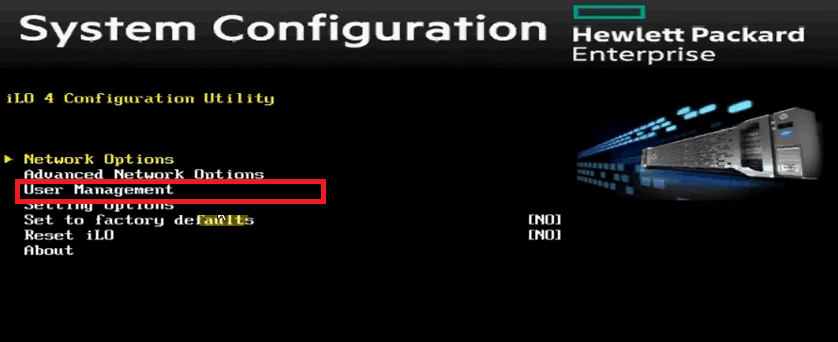

This machine has also the HPQLOCFG.exe utility installed which is used to run the RIB script. To set the LDAP settings we have created the RIB XML script above and have it available on the machine we are running the script from. I suspect that iLO contacts all of the domain controllers before logging in. However I found that logging in to iLO with an AD account took a very long time when the domain name was specified. Regarding the DIR_SERVER_ADDRESS this also supports the domain name it self making it more available in case the domain controller you specify is down. Here's an example of one of our RIBCL scripts Luckily there are nice examples on how this is done in the HPE documentation. Things like the mapping of AD groups to permissions and so forth have to be done through the RIBCL scripting methods which essentially is running/flashing an XML file on the iLO. There is (I haven't found a way at least) no way to set all of the required LDAP integration settings through the provided Powershell modules. Now we are ready for configuring the AD/LDAP integration. Set-HPiLONetworkSetting -Server $ILOIp -Username $UserName -Password $adminPass -DisableCertificateAuthentication -DHCPEnable Disable -RegDDNSServer Disable -RegWINSServer Disable -DNSName $iloName -PrimDNSServer $prim_dnsserver -SecDNSServer $sec_dnsserver -DHCPDNSServer DisableĪs you notice we are both setting the name of the server (-DNSName) and the primary and secondary DNS servers (-PrimDNSServer / -SecDNSServer).Īfter this setting the iLO will most likely reset, in our script we have put in a Start-Sleep for 2 minutes to wait for the iLO to come back online. The next step is to set the different network settings, namely step 2 and 3 in the above list. Note the different privileges the user are getting through the parameters of this cmdlet. Also note that you need to add the -DisableCertificateAuthentication switch parameter if you haven't replaced the self-signed SSL certificates.

#Hp ilo 4 xml configuration password
The new username and password are set as input variables to the script Add-HPiLOUser -Server $ILOIp -Username $UserName -Password $adminPass -NewUsername $NewUserName -NewUserLogin $NewUserName -NewPassword $pass -AdminPriv Y -ConfigILOPriv Y -RemoteConsPriv Y -ResetServerPriv Y -VirtualMediaPriv Y -DisableCertificateAuthentication We are adding our own admin user which is stored in a separate secret/password manager. HPQLOCFG.exe Update: Script has been changed to use the Invoke-HPiLORIBCLCommand cmdlet from the HP iLO moduleįirst of we are using the HP iLO cmdlets to add the new admin user and to set the name and DNS configuration.The script uses four different HPE tools to configure the different components: We have created a script that does all of these steps, but they can and will also be extracted in single functions/scripts so they can be used individually.

Create and assign OneView server profile from a template (includes BIOS settings and Firmware baseline).So to our steps for initial configuration of a new rack server (after racking, stacking and bringing the iLO online): As we have had mostly blade servers there hasn't been that much need for managing BIOS or iLO on single servers as this is done through OneView or OA, but there are Powershell modules for that as well. We have been using the OneView module for some time, and also the OneView APIs directly. HPE has released a lot of Powershell modules for managing various parts of their infrastructure components. To the rescue comes the APIs provided by HPE and our favourite tool, Powershell. With lots of new servers to configure this is a tedious process, and there are risk for errors and inconsistency when doing it manually.

They will also have to be added to OneView manually while the blades would be brought in automatically from the chassis. These will also be managed by OneView primarly, but initially we need to do some iLO config on each server which in the case of blades are done by the OA. Our latest batch of new hardware however was D元60 and D元80 rack servers. For managing these we are primarly using HPE OneView and in some cases the Onboard Administrator (OA). We have quite a few Blade Enclosures with BL460c server blades in them and have been happy with those.


 0 kommentar(er)
0 kommentar(er)
